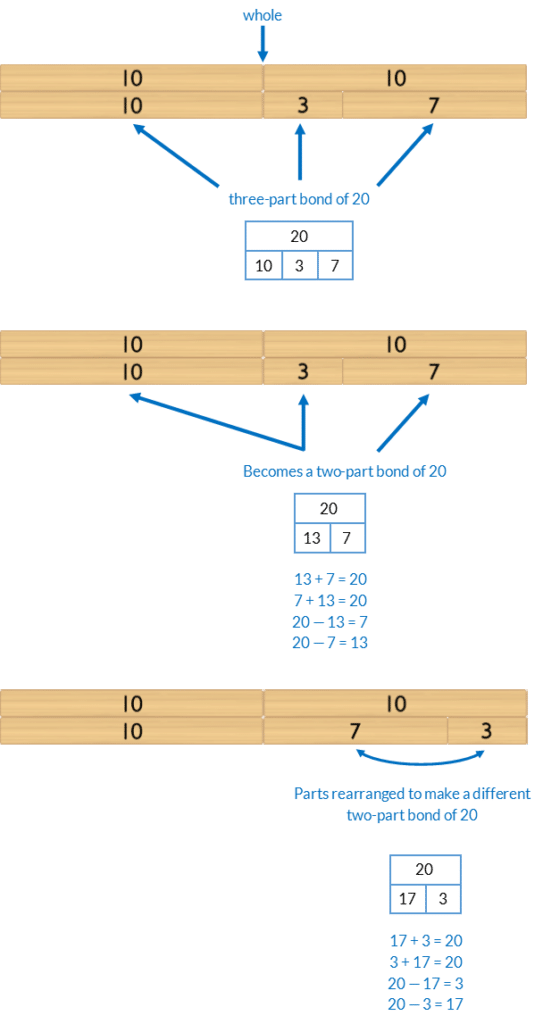46) Equation
Ten Plus Bonds: Building
Mathematics
Develop the concept of:
- Two-part bonds of 20, where one part is a ten plus bond.

- The associative property of addition: three or more parts can be added in any order without changing the size of the whole.
Each three-part bond of 20 is rearranged to make two, two-part bonds of 20.
Each two-part bond of 20 has one part that is a ten-plus bond.

- Related addition and subtraction equations, rearranged using the part-part-whole relationship, for two-part bonds of 20, where one part is a ten plus bond.
- Mathematics as the science of pattern.
Language
- “(Part) and (part) is (whole)” eg “19 and 1 is 20”
- three-part bond
- two-part bond
- ten plus bond
- bond of 10
- addition as “add”
- subtraction as “subtract”
- equals
- associative property of addition

Differentiation
A little easier
Skill Focus: addition then subtraction
When completing the core activity it is recommended that students complete the addition and subtraction equations working horizontally across the board one bond at a time. However, students with executive processing difficulties may find swapping between addition and subtraction confusing.
Adjust the activity by instructing students who have difficulty with this to complete the board vertically, filling the column of addition in one session, and the column of subtraction in a separate session.

Signalling: colour code
Colour cod the related bonds of 10. After building the wall and verbalising the two-part bonds of 20 select four different coloured dry eraser markers.
- Circle the two-part bonds of 20 that use related bonds of 10.
- Verbalise these related bonds together. For example, “11 and 9 is 20 so 19 and 1 is 20”. Touch the related parts as they are said.

A little harder
Equations: three-part bond
Write equations using three part wholes of 20. One part in each equation must be a part of 10. Build the three-part whole using Bond Blocks then write as many addition and subtraction equations using those three parts as possible. For example,

Click this link to read Teacher Notes for more information about “Extending Part-Part-Whole” to building equations with three parts (pages 5-7).
Equations: part-part-whole rearranged
Addition and subtraction equations don’t have to be written as
Part + Part = Whole
Whole – Part = Part
An alternative arrangement is
Whole = Part + Part
Part = Whole – Part

Click this link to read Teacher Notes for more information about “Atypical Arrangement using Part-Part-Whole” (pages 8-9).
Progression
In the next activity students build on the concept of creating addition and subtraction equations, for ten plus bonds of 20, to develop fluency expressing these addition equations verbally. Go to
Activity 42
Ten Plus Bonds: Addition, Building a Wall

